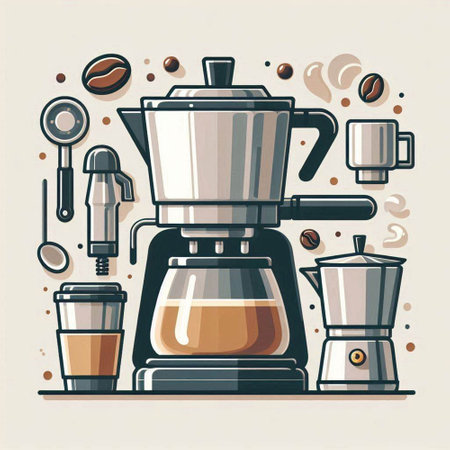1. Understanding What Fair Trade Coffee Means
When you’re shopping for coffee in the U.S., you might see bags labeled “Fair Trade.” But what does fair trade coffee really mean? It’s more than just a label—it’s about supporting ethical practices that benefit everyone along the coffee supply chain, from the farmers who grow your beans to the environment and even you as a consumer.
Key Principles of Fair Trade Coffee
| Principle | What It Means |
|---|---|
| Ethical Sourcing | Coffee is bought directly from growers or cooperatives at a fair price, avoiding middlemen who might exploit farmers. |
| Environmental Standards | Farmers use sustainable farming methods that protect natural resources and reduce harm to the environment. |
| Fair Compensation | Growers are paid a minimum price that covers their costs and allows them to earn a living wage, even when market prices drop. |
Why Fair Trade Matters in the U.S. Market
Many American consumers care about where their products come from and want to make purchases that align with their values. By choosing fair trade coffee, you support:
- Human Rights: Ensuring farmers are treated fairly and can support their families.
- Sustainability: Encouraging eco-friendly farming that preserves land and water for future generations.
- Community Development: Fair trade premiums often fund schools, health clinics, and other local projects in coffee-growing regions.
How Is Fair Trade Different From Regular Coffee?
| Fair Trade Coffee | Regular Coffee | |
|---|---|---|
| Sourcing Process | Direct, transparent relationships with farmers/co-ops | Often through multiple middlemen, less transparency |
| Farmer Compensation | Guaranteed minimum price plus premiums | Fluctuates with the market, often below living wage |
| Environmental Impact | Sustainable practices required | No specific requirements for sustainability |
| Social Benefits | Community investments funded by premiums | No guaranteed community benefits |
The Takeaway: What to Look For When Shopping
If you want your morning cup to make a positive impact, understanding these principles is the first step. Look for credible fair trade certifications and read labels carefully—knowing what fair trade stands for helps you make choices that reflect your values and support coffee-growing communities around the world.
2. Spotting Legitimate Fair Trade Certifications
If you’re shopping for fair trade coffee in the U.S., knowing how to spot real, trustworthy certifications is key. With so many brands making claims, it’s important to recognize which labels are credible and what they actually mean for farmers and the environment.
Most Recognized U.S. Fair Trade Certification Labels
Here are some of the most trusted fair trade certification organizations you’ll find on coffee products in American stores:
| Certification Logo | Name | What It Means | Who Oversees It |
|---|---|---|---|
 |
Fairtrade International (FLO) | Ensures ethical sourcing, fair wages, and sustainable practices for farmers. | Fairtrade America |
| Fair Trade Certified™ | Focuses on transparent supply chains, fair pay, and environmental protections. | Fair Trade USA | |
 |
USDA Organic* | Not a fair trade label, but often seen alongside. Indicates organic farming practices. | U.S. Department of Agriculture |
 |
Rainforest Alliance Certified* | Mainly about sustainability, sometimes overlaps with fair trade values. | Rainforest Alliance |
*While USDA Organic and Rainforest Alliance focus more on environmental standards, many ethically-minded brands use these labels along with true fair trade certifications to show broader commitments.
How to Tell If a Label Is Legitimate?
- Check the exact wording: Look for “Fairtrade” or “Fair Trade Certified.” Phrases like “fairly traded” without an official logo may not mean much.
- Look for the official seal: Authentic certifications have distinct logos. Don’t rely on packaging designs or vague claims alone.
- Visit the certifier’s website: If unsure, go to the certifying organization’s site (like Fairtrade America) and use their product locator tools or check their list of certified brands.
- Avoid misleading language: Words like “direct trade” or “responsibly sourced” can sound good but aren’t regulated by third parties unless paired with a real certification logo.
Coffee Shopping Tip:
If you want to be sure your coffee supports ethical practices, stick with brands that display one of the major U.S. fair trade certification seals listed above. These organizations audit farms and supply chains regularly, so you know your purchase makes a real difference.

3. Reading Coffee Packaging Like a Pro
If you want to make sure your coffee is truly fair trade, knowing how to read and understand coffee packaging is a must. Many brands use buzzwords to attract customers, but only some deliver real transparency and traceability. Here’s how you can spot authentic fair trade coffee on U.S. shelves.
Key Fair Trade Identifiers to Look For
| Identifier | What It Means | Where to Find It |
|---|---|---|
| Fair Trade Certified™ Seal | Third-party certification showing the coffee meets fair trade standards. | Front or back of the package, usually near the logo or ingredient list. |
| USDA Organic Seal (optional) | Coffee is grown without synthetic pesticides and aligns with organic practices, often paired with fair trade. | Near the Fair Trade seal or on the front label. |
| Certifying Body Name (e.g., Fair Trade USA, Fairtrade International) | Tells you which organization certified the product, adding credibility. | Usually listed under the seal or in small print on the back. |
Transparency in Source Information
The more details a coffee brand shares about where their beans come from, the better. Look for packaging that mentions:
- Farm or Cooperative Name: Specific names give you a direct link to the source.
- Country and Region: Reputable brands go beyond just “Imported” and provide exact origins like “Huehuetenango, Guatemala.”
- Harvest Date: Freshness matters—some brands even print this info to prove quality.
Traceability Back to the Farm
A big part of genuine fair trade coffee is being able to trace it back to its roots. Some U.S. brands offer QR codes or website links right on the packaging. Scanning these can show you:
- The journey of your coffee beans from farm to cup
- Information about the farmers and their communities
- Sustainability and social impact stories related to that specific batch
Quick Checklist for Authentic Fair Trade Coffee Packaging
- Look for recognized fair trade certification seals
- Check for detailed source information—not just generic claims
- See if there’s a way to trace your coffee back to the farm via QR code or batch number
- Avoid vague language like “ethically sourced” unless it’s backed by real certification and info
By getting familiar with what honest, transparent packaging looks like, you’ll have a much easier time picking out real fair trade coffee during your next grocery run.
4. Avoiding Greenwashing and False Claims
Watch Out for Misleading Marketing
In the U.S. coffee market, some brands use buzzwords and pretty packaging to make their coffee seem more ethical or sustainable than it actually is. This is called “greenwashing.” To really support fair trade farmers, you need to know how to spot these red flags.
Common Red Flags in Coffee Marketing
| Marketing Claim | What It Might Mean | What to Look For Instead |
|---|---|---|
| “Ethically Sourced” | This term isn’t regulated and doesn’t guarantee fair trade practices. | Look for official Fair Trade certification seals. |
| “Sustainably Grown” | No clear definition; could mean almost anything. | Check if they mention a specific certification or partnership with recognized organizations. |
| “Direct Trade” | Sometimes true, sometimes just a marketing tool. No third-party verification. | Ask for details about the farms and proof of direct relationships. |
| “Supporting Farmers” | Vague claim; may not include fair pricing or labor standards. | See if they disclose payment terms, community projects, or actual impact reports. |
Buzzwords That Don’t Guarantee Fair Trade
- All Natural: Says nothing about social or economic standards for farmers.
- Premium Blend: Just a quality statement, not an ethical one.
- Farm Fresh: Implies freshness, but not farmer treatment or pay.
- Handcrafted: Can sound nice but doesn’t connect to fair trade principles.
How to Double-Check Coffee Claims
- Look for Certification Logos: The Fair Trade Certified seal is your best bet. Also check for Rainforest Alliance or USDA Organic for additional standards (but remember, only Fair Trade Certified guarantees fair pricing).
- Read the Fine Print: Honest brands will explain their sourcing and impact clearly on their website or packaging.
- Email or DM the Brand: If in doubt, ask! A reputable company will be transparent about its supply chain and certifications.
- Avoid Overly Vague Promises: If something sounds too good—and there’s no proof—it probably isn’t genuine fair trade coffee.
Your Best Move?
If you want real fair trade coffee in the U.S., always look past the fancy words and check for real certification. This way, your cup supports farmers as much as it satisfies your taste buds.
5. Shopping Smart: Where to Buy Authentic Fair Trade Coffee
If you’re looking to support fair trade practices and enjoy ethically sourced coffee, knowing where to buy is just as important as knowing what to look for on the label. In the U.S., both online and brick-and-mortar stores offer plenty of options, but some places are more reliable than others. Here’s a handy guide to help you shop smart and find authentic fair trade coffee with confidence.
Trusted Places to Buy Fair Trade Coffee in the U.S.
| Retailer Type | Examples | Why Choose This Option? |
|---|---|---|
| Supermarkets & Grocery Chains | Whole Foods Market, Trader Joe’s, Kroger, Safeway | Wide selection; look for dedicated fair trade sections or signage |
| Specialty Coffee Shops & Cafés | Blue Bottle Coffee, Stumptown Coffee Roasters, Peet’s Coffee | Baristas can often tell you about sourcing; usually carry certified beans |
| Online Retailers | Amazon, Thrive Market, FreshDirect, Bean Box | Convenient; filter by “Fair Trade Certified” to narrow choices |
| Direct from Roasters/Brands | Equal Exchange, Counter Culture Coffee, Allegro Coffee | Full transparency on sourcing; often ship nationwide |
| Farmer’s Markets & Local Co-ops | Your local market or community co-op store | Support small businesses; ask vendors directly about certifications |
Tips for Buying Fair Trade Coffee in Stores
- Look for Labels: In-store, always check for the official “Fair Trade Certified” logo on the packaging.
- Ask Questions: Don’t hesitate to ask staff about their coffee’s sourcing and certifications.
- Avoid Greenwashing: Words like “sustainable” or “ethical” don’t always mean fair trade—look for real certification!
- Check Store Websites: Many retailers highlight their fair trade products online before you even visit.
Navigating Online Purchases of Fair Trade Coffee
- Use Filters: Most major sites let you filter your search by certifications like “Fair Trade.”
- Read Reviews: Customer feedback can give clues about authenticity and quality.
- Buy Direct When Possible: Purchasing straight from roasters or fair trade brands ensures better traceability.
- Avoid Unclear Listings: If a product doesn’t clearly show its certification status, it may not be authentic.
Your Go-To Checklist for Finding Authentic Fair Trade Coffee Retailers:
- Select stores or websites known for ethical sourcing.
- Always verify that the “Fair Trade Certified” seal is visible (either in person or in product photos online).
- If in doubt, contact customer service or visit the official Fair Trade USA website for a list of verified partners.
- Remember: Higher price doesn’t always equal authentic—certification matters most!
The Bottom Line on Shopping Smart for Fair Trade Coffee in America:
No matter where you live in the U.S., there are trustworthy places to find real fair trade coffee. Whether you prefer shopping in person at your neighborhood grocery store or browsing online for the best deals, sticking to reputable retailers and checking for proper certification will help you make purchases that truly make a difference—for farmers and for our planet.

